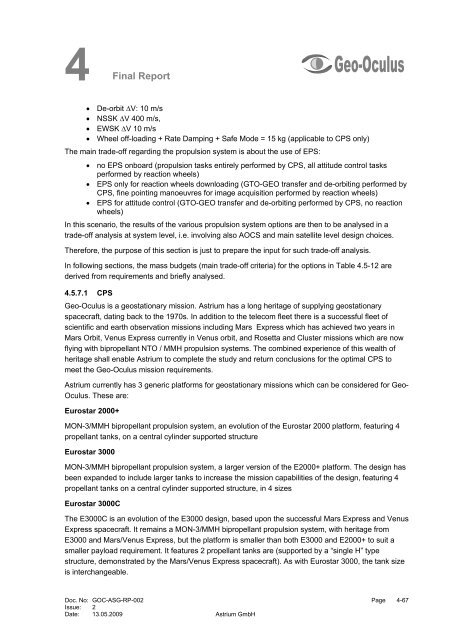4 Final Report - Emits - ESA
4 Final Report - Emits - ESA
4 Final Report - Emits - ESA
You also want an ePaper? Increase the reach of your titles
YUMPU automatically turns print PDFs into web optimized ePapers that Google loves.
4 <strong>Final</strong><br />
<strong>Report</strong><br />
• De-orbit ΔV: 10 m/s<br />
• NSSK ΔV 400 m/s,<br />
• EWSK ΔV 10 m/s<br />
• Wheel off-loading + Rate Damping + Safe Mode = 15 kg (applicable to CPS only)<br />
The main trade-off regarding the propulsion system is about the use of EPS:<br />
• no EPS onboard (propulsion tasks entirely performed by CPS, all attitude control tasks<br />
performed by reaction wheels)<br />
• EPS only for reaction wheels downloading (GTO-GEO transfer and de-orbiting performed by<br />
CPS, fine pointing manoeuvres for image acquisition performed by reaction wheels)<br />
• EPS for attitude control (GTO-GEO transfer and de-orbiting performed by CPS, no reaction<br />
wheels)<br />
In this scenario, the results of the various propulsion system options are then to be analysed in a<br />
trade-off analysis at system level, i.e. involving also AOCS and main satellite level design choices.<br />
Therefore, the purpose of this section is just to prepare the input for such trade-off analysis.<br />
In following sections, the mass budgets (main trade-off criteria) for the options in Table 4.5-12 are<br />
derived from requirements and briefly analysed.<br />
4.5.7.1 CPS<br />
Geo-Oculus is a geostationary mission. Astrium has a long heritage of supplying geostationary<br />
spacecraft, dating back to the 1970s. In addition to the telecom fleet there is a successful fleet of<br />
scientific and earth observation missions including Mars Express which has achieved two years in<br />
Mars Orbit, Venus Express currently in Venus orbit, and Rosetta and Cluster missions which are now<br />
flying with bipropellant NTO / MMH propulsion systems. The combined experience of this wealth of<br />
heritage shall enable Astrium to complete the study and return conclusions for the optimal CPS to<br />
meet the Geo-Oculus mission requirements.<br />
Astrium currently has 3 generic platforms for geostationary missions which can be considered for Geo-<br />
Oculus. These are:<br />
Eurostar 2000+<br />
MON-3/MMH bipropellant propulsion system, an evolution of the Eurostar 2000 platform, featuring 4<br />
propellant tanks, on a central cylinder supported structure<br />
Eurostar 3000<br />
MON-3/MMH bipropellant propulsion system, a larger version of the E2000+ platform. The design has<br />
been expanded to include larger tanks to increase the mission capabilities of the design, featuring 4<br />
propellant tanks on a central cylinder supported structure, in 4 sizes<br />
Eurostar 3000C<br />
The E3000C is an evolution of the E3000 design, based upon the successful Mars Express and Venus<br />
Express spacecraft. It remains a MON-3/MMH bipropellant propulsion system, with heritage from<br />
E3000 and Mars/Venus Express, but the platform is smaller than both E3000 and E2000+ to suit a<br />
smaller payload requirement. It features 2 propellant tanks are (supported by a “single H” type<br />
structure, demonstrated by the Mars/Venus Express spacecraft). As with Eurostar 3000, the tank size<br />
is interchangeable.<br />
Doc. No: GOC-ASG-RP-002 Page 4-67<br />
Issue: 2<br />
Date: 13.05.2009 Astrium GmbH

















